A Cycle of Death and Renewal at DeSoto State Park
See my August 1, 2018 post for a look at “What Lies Hidden Within” from a July 19 hike at DeSoto. I focused on non-flowering plants, and the beauty, magic, wonder, and awe that to many visitors lie hidden within plain sight. View this post as Part-II of that July 19 visit, with a focus other than non-flowering plants.
Nature’s Cycle of Death and Renewal
Most hikers see the forest and perhaps the trees. Few pay much attention to the non-flowering plants. I saw the forest, the trees, the non-flowering plants, and an abundance of evidence telling me that nothing in Nature is static. I walked the Boardwalk Trail back to Azalea Cascade twice that day, the first in pre-4:00AM total darkness, flashlight in-hand. I came to a place where recent railing and deck repairs brought me to a halt. My light revealed a massive white oak blow-down, having fallen from uphill, obliterating the boardwalk, but quickly and masterfully repaired. A full canopy of now dry and brown leaves suggested that the tree had toppled within the past 30 days. The stump diameter looked to be about three feet. The up-turned root mass and soil stood at six-feet, exaggerated in the darkness. I snapped the photos below during my afternoon return stroll, looking uphill at the root-mass.
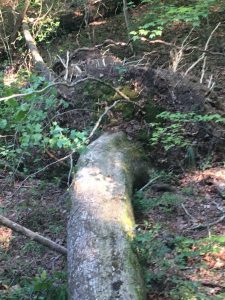
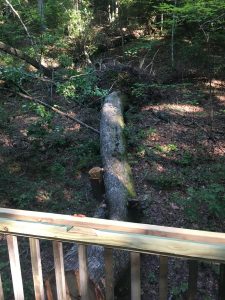
Lower left below looks into the downed crown, beyond the boardwalk, and includes some of the smaller trees the oak brought down with it. At lower right, I am looking back at the main boardwalk from where I had taken the lower left photo. The oak just missed this side-spur that leads out to a gazebo. What a frighteningly close view that would have been during the big wind, which park personnel revealed to me had accompanied an afternoon thunderstorm two weeks prior. Weather and climate patterns can be global, yet impacts can vary over a matter of feet. Picture the storm damage that leaves one house intact and its neighbor destroyed. A boardwalk is nothing to a multi-ton, 100-foot oak. So much in Nature is random and chaotic. A three-degree shift in angle of fall would have crushed 70-feet of spur boardwalk and the gazebo.
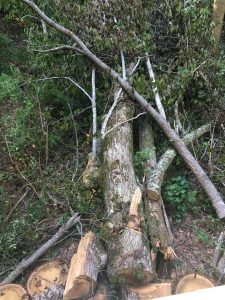
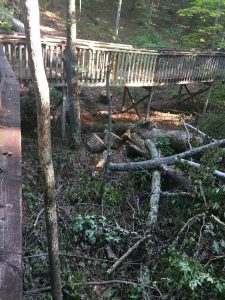
Nature will fill the gap left by the mighty oak. Neighbors will extend branches and foliage into the opening. Individuals in the intermediate canopy will reach vertically for the light above. The forest floor’s vegetative carpeting will respond to the new light. The opening will be evident to only the most astute and aware observer ten years hence. Nature abhors a vacuum. A summer thunderstorm with damaging winds is nothing to a forest. The forest is a living system designed to respond to blow-down and fill resultant vacuums… at any point in time, and over the long reach of centuries and beyond.
Not all wind bursts uproot living trees. The 15-inch diameter Virginia pine (below left) broke with a wrenching twist three feet from its base. I’m estimating 12-24-months ago, given the progress since of canopy breakdown (lower right). The standing pines are fading, with crowns thinning (again, below right). The residual stand is doing what Virginia pine is designed to do — fill an ecological gap (an abandoned pasture, or the aftermath of severe disturbance like fire or area-wide blowdown), and then 50-90 years hence pass the torch through succession to mixed hardwood. This Virginia pine stand is passing the baton, slowly and inexorably.
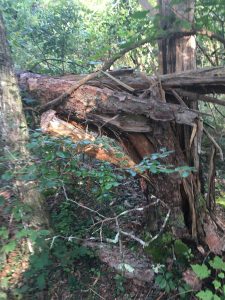
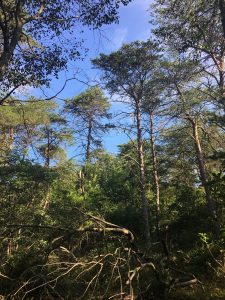
The two-weeks-ago storm tore the top from another oak, blocking a trail and making the punch-list of necessary trail work. Perhaps no one knows Nature’s dynamism better than trail maintenance crews! Again, nothing in Nature is static.
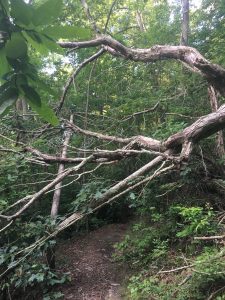
Gradual Change and Subtle Processes
Not all trees die from a catastrophic uprooting or trunk-snapping. Many die standing, victims to insect, disease, competition, or wind or ice taking out the crown. Again, nothing in Nature is static. The 18-inch-diameter oak (lower left) is decaying in-place. Fungi, insects, small mammals, and birds are feasting on the cellulose… or on critters consuming the cellulose. A vertical smorgasbord! Eventually (and always) gravity will pull it ground-ward, where the decay pace will accelerate with the gift of more reliable moisture and ground-dwelling consumers. The horizontal, former 24-inch trunk (lower right) is heading toward humus. Roots are likely already exploiting the richly decaying ground-contact decay zone on the log’s underside. In the blink of a forest’s eye, molecules from the decaying log will find themselves once more 50-feet up in the canopy of an oak now still in acorn stage.
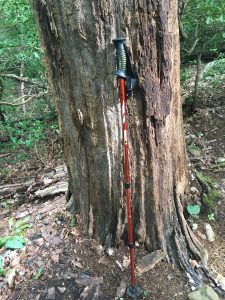
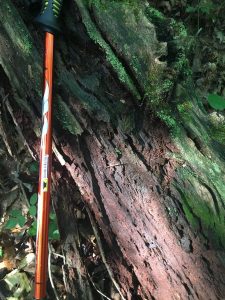
Perhaps a squirrel recently cached that acorn in the loose soil and organic matter along the old trunk. It could be a banner acorn year and she may not find this particular hidden morsel. It may germinate next spring, and eventually survive deer browsing and ultimately reach into the main canopy… and someday feel the fury of a summer thunderstorm, yield to the tempest, crash to the ground, decay, and serve as as a hiding place for yet another acorn. Nature never stands still. And time is nothing to a succession of forests, century after century. The story of death and renewal is there for those willing to read Nature’s language.
Again, over the long reach of centuries, even the forest soil turns and churns. The Boardwalk oak blowdown brought up many cubic feet of Nature’s precious rooting medium, much as a farmer may turn his field. Nature’s process mixes soil from 2-4 feet deep with rich surface soil. Even the upturned soil mound tells a tale. The star of the tale is a super-power we’ll call Raindrop. The exposed soil has little protection from the force of rain falling through and from the canopy. Small rocks serve as shields, standing on pedestals below. Vertical columns support each shield, and even they will weaken and yield. The mound will soften and become a shallow hummock covered by forest litter, mosses and lichens, and understory plants. Many of our Alabama forests evidence centuries of windthrow with signature “pit and mound” topography. Watch for it. If not apparent, the site likely supported agriculture at some point, smoothing away the former forest blowdown evidence. The resultant agricultural abandonment opened succession’s door to forest again occupying the land. Static does not exist in Nature, which loathes a vacuum.
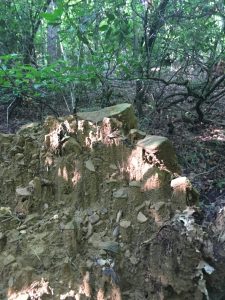
I’ve observed repeatedly in these posts that time means nothing to Nature — it is only we humans who pay attention to time’s relentless passage. It is only we who are conscious of our race into tomorrow at 60-seconds per minute. My long-time good friend and mentor, retired NC State Forestry Professor Bob Kellison, sent me a note in response to last week’s post wherein I mentioned finding lots of persimmons on the ground at Lake Guntersville State Park. Bob and I share kindred appreciation for both Nature and subtle, country humor. Here is what he sent me: An old mountaineer was holding a pig in his arms while it was feeding on persimmons from a low-hanging branch. A passerby remarked to the mountaineer that it would take a long time to fatten the hog on persimmons in such manner. The mountaineer’s response was “Aw, time don’t mean nothin’ to a pig.” Bob has planted a seed — I will strive to insert a little more levity into future posts.
Reflections and Lessons
I’ve often observed that some people walk through the woods, intent on transiting from point ‘A’ to point ‘B,’ focused on miles logged, and destinations. I’ve been guilty as well. However, I have come to accept that I most enjoy walking within the forest. Some folks live for overlooks — scenic views. Granted, I relish such vistas as well. Yet if an overlook were my sole focus, there is way too much that I would, in fact, overlook. Regrettably, we are a society dedicated to overlooking the obvious, the wondrous, and the inspirational. Doesn’t that apply too often as well to life in general? We tend to walk through life, rather than journeying within life. Are we conscious of life cycles… of process and flow? Do we simply transit from one static moment to the next, without appreciating the flow?
Do we read the story? The tale of passage… of integration over time? Do we understand and learn from what the journey reveals? Do we realize that absolutely nothing is permanent — in our lives or in Nature? The cycles of life, decline, and renewal apply to Nature, business, economies, societies, and to humanity as a whole. There are no guarantees, but only that change and progression are inevitable. We serve ourselves best when we understand the cycles, anticipate change, and do all in our power to influence and deal with the flows and processes.
How does humanity fit in Earth’s cycles of death and renewal. Are we doing all we can to assure that humanity is more than a footnote in time? Humanity serves itself best when we understand the cycles, anticipate change, and do all in our power to influence and deal with the flows and processes. Humanity’s fate is in our hands. I want my hikes and these Great Blue Heron blog posts to serve as reminders that we are blessed with Nature and Earth’s abundant beauty, magic, wonder, and awe.
We as individuals and in our aggregate humanity must view our place locally, where we live, work, and play, and ultimately, globally. I can influence only locally… through my writing and speaking, one individual at a time. My role is to inspire and persuade all who will read and hear. My intent is to use the local as a means of lifting others to appreciate the global context… and our imperative to steward our One Earth.
And so I will focus on where my wanderings take me. This essay took me back to DeSoto State Park. Through these words and photos I am planting my acorn of inspiration and reflection. May the acorn germinate, find traction, and grow to be The Mighty Oak of your understanding and commitment. Our Alabama State Park System is invaluable salve for my soul and fodder for these clarion calls for action.
Our Alabama State Park system is a necklace of 22 pearls; 48,000 acres of natural treasure. One of my bucket list items is to visit all 22; hike their trails; chronicle the visits; and tell their land legacy stories. And use them to educate, develop, and inspire future generations of aware Nature enthusiasts. May your own vision be realized through Nature’s lessons and inspiration.
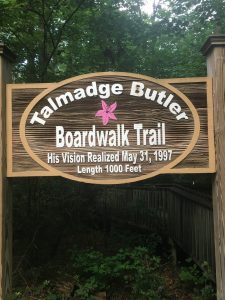
Note: All blog post images created & photographed by Stephen B. Jones unless otherwise noted. Please circulate images with photo credit: “©2018 Steve Jones, Great Blue Heron LLC. All Rights Reserved.”
Another Note: If you came to this post via a Facebook posting or by an another route, please sign up now (no cost… no obligation) to receive my Blog Post email alerts: https://stevejonesgbh.com/contact/
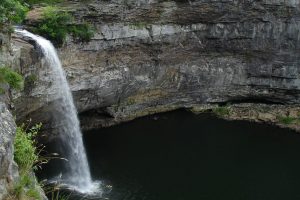
Official Alabama State Parks photo of DeSoto Falls
A Final Lesson for the Day: Time don’t mean nothin’ to a pig!


